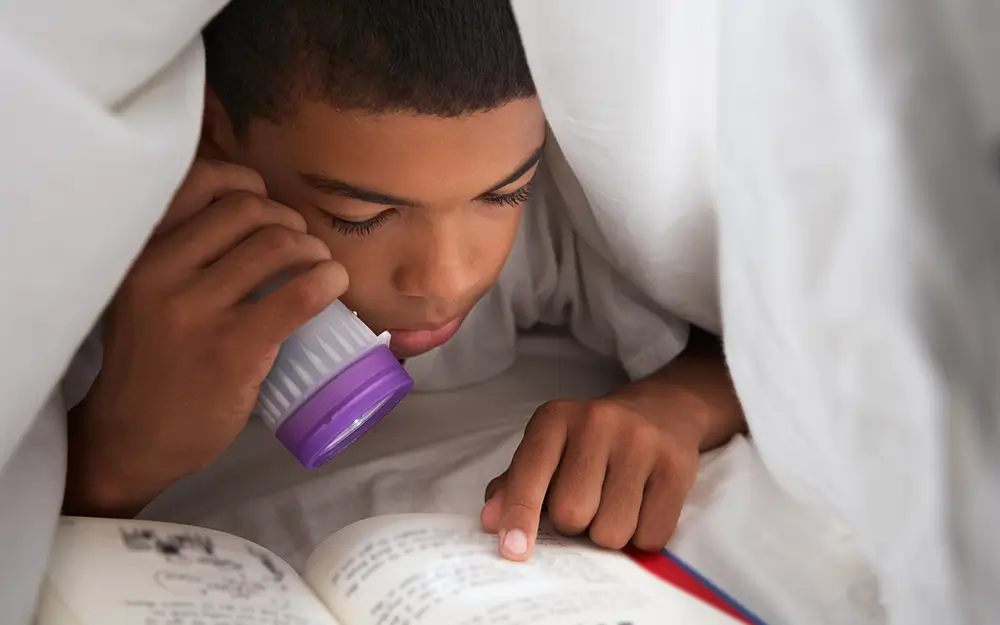How to Help Your Child Sleep Better
Children need around 10-14 hours of sleep each night, depending on their age, and that sleep is essential for their growth, development, and overall well-being. And when they sleep well, you do too.
Creating a healthy sleep environment goes far beyond choosing the right mattress and bed. As Mattress Online’s Head of Sleep Science, I’m here to help you support your child’s sleep with expert guidance, so your whole family can rest easier.

Consider their whole sleeping environment
A calm, secure bedroom helps your child fall asleep more easily and sleep more soundly through the night. Beyond the comfort of their bed, it’s the small details that matter, from lighting and noise to the layout of their bedroom.
For example:
- Clothes hanging on the back of a door might cast unfamiliar shadows that make a child feel uneasy
- Bright, overstimulating colours in their bedroom can make it harder for children to wind down
- Toys left out in the bedroom may tempt your child to play instead of sleep

When a child sleeps better, it supports their mood, focus, and physical development, so creating the right environment is essential.
Make sure they feel safe
When children feel safe and secure in their sleeping space, their quality of sleep often improves. This sense of emotional security supports both mental well-being and healthy development.
You can help create that sense of safety with simple touches:
- Cosy bedding or blankets
- Familiar stuffed animals or comfort items
- A consistent, relaxing bedtime routine (like reading a book or listening to soft music)

Keep their room cool and comfortable
There’s no one-size-fits-all ‘perfect’ bedroom temperature - but in general, a cooler room helps children fall asleep faster and stay asleep longer.
Here are some simple ways to maintain a comfortable temperature in their bedroom:
- Turn down the radiator, or switch it off completely during warmer months
- Place a cool, damp cloth beside their bed to help them cool down quickly if needed
- Keep curtains or blinds closed during the day to block out sunlight and prevent heat build-up
- Close windows on hot days to keep warm air out, and open them in the evening once it cools
These steps can help prevent overheating, keeping your child more comfortable through the night.
Encourage a calm and relaxed wind-down routine
A good night’s sleep starts well before lights out. A consistent, relaxing wind-down routine helps signal to the brain and body that it's time to sleep.
If your child has trouble settling, try making these small changes:
- Avoid large meals close to bedtime - digestion raises core body temperature and can delay sleep
- Skip hot baths and showers close to bedtime - opt for a lukewarm shower or bathe earlier in the evening
- Time exercise earlier in the day - vigorous activity late in the evening can make it harder to fall asleep
- Avoid stimulating media close to bedtime - action-packed shows or games can make it harder for them to wind down
- Try a calming activity for about 60 minutes before bed - such as reading, gentle colouring or listening to soothing music while they talk about their day

How to create an allergy-friendly bedroom
If your child has allergies or sensitive skin, their sleep may be disrupted by common allergy symptoms such as coughing, sneezing, watery eyes and skin irritation.
Common bedroom allergens include:
- Dust mites - Droppings of dust mites contain proteins that trigger allergic reactions
- Mould spores - Often found in damp areas, mould can worsen respiratory issues
- Pet dander - The tiny flecks of skin shed by cats and dogs, known as pet dander, can trigger allergies
- Pollen - Brought in from outside, pollen can accumulate in bedding and carpets
- Bacteria and fungi - Warm, humid sleeping conditions can cause bacteria and fungi to thrive

Tips to reduce allergens
- Wash bedding regularly at 60°C
- Vacuum mattresses and carpets weekly
- Let the mattress air out each morning
- Keep pets out of the bedroom, or at least off the bed, if possible
These simple tips can make a world of difference to children suffering from allergies at night, but always follow the manufacturer’s care instructions when washing bedding and cleaning the mattress.
Mattress and bedding options for allergy-prone children
If your child has sensitive skin or suffers from allergies, making the right mattress and bedding choice is essential.
It’s helpful to understand the difference between hypoallergenic and anti-allergy mattresses and bedding:
- Hypoallergenic: Made from materials less likely to trigger allergies. Look for certifications like OEKO-TEX® or CertiPUR®, which guarantee the mattress and bedding are free from harmful substances. Ideal for children with sensitive skin.
- Anti-allergy: These mattresses and bedding are treated to reduce allergens like dust mites. For extra peace of mind, look for the Allergy UK Approved™ logo.
While nothing can completely eliminate allergens, a regular cleaning routine and an understanding of how to create an allergy-friendly sleeping environment can help your child enjoy deeper, uninterrupted sleep.
For more advice on managing allergies, explore our full guide: How to Sleep Better With Allergies.
Your child’s sleep affects every part of their wellbeing — from physical growth to mood, learning, and emotional development. Finding a sleep routine and setup that works for your family can make a lasting difference.
I hope this guide has helped you feel more confident about supporting your child’s sleep and getting better rest yourself, too.
More kids sleep advice:
Looking for sleep tips for yourself? Check out these helpful guides:
About our Team
A University of Oxford-trained sleep specialist and published researcher, Hannah's dedicated to improving your sleep through evidence-backed advice and product insights.
Sales Enquiries
Mon-Sat: 9:30am - 5:30pm
Sunday: 10am - 4pm
Customer Service
Mon-Sat: 9:30am - 5:30pm
Sunday: 10am - 4pm









